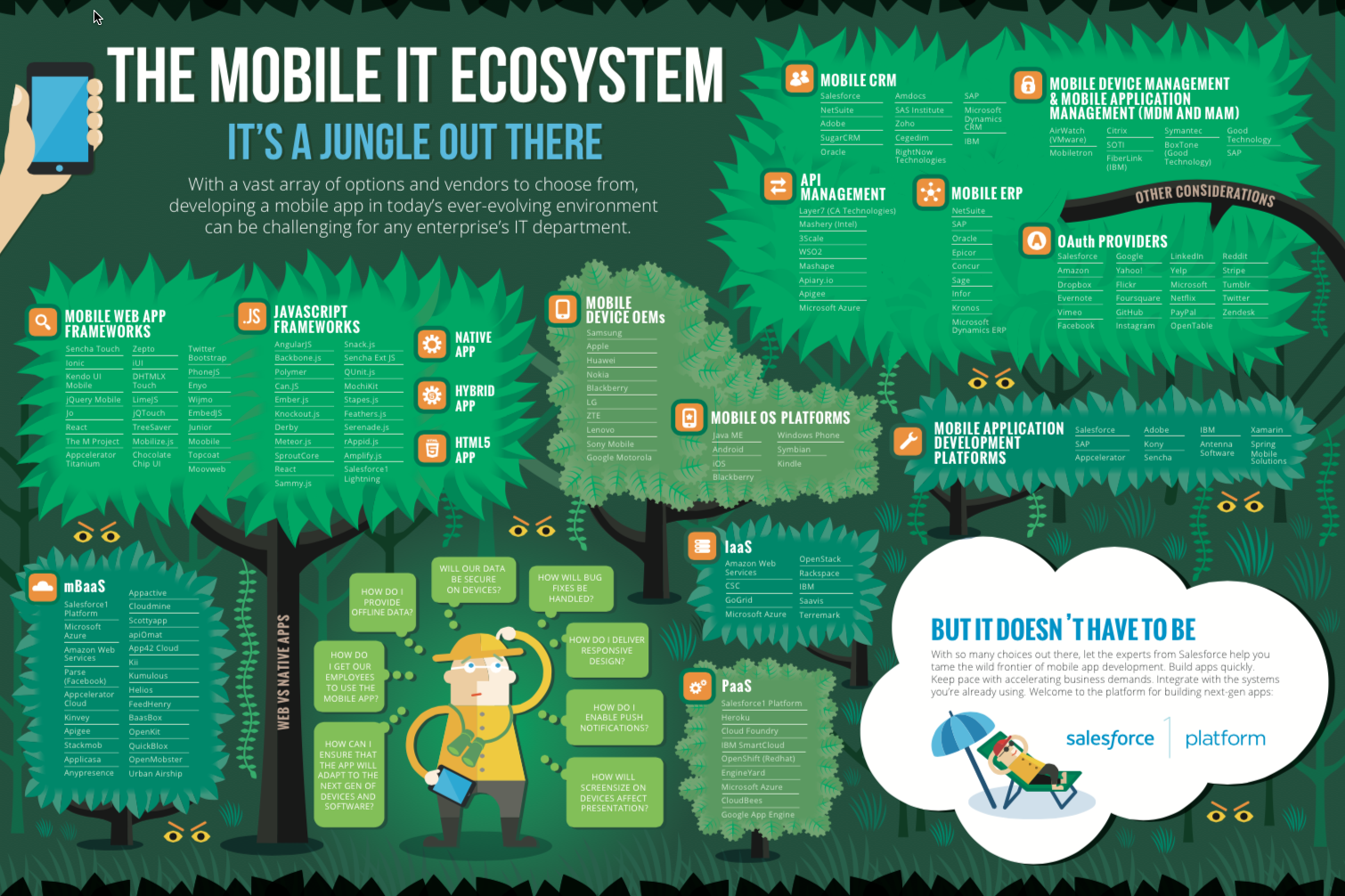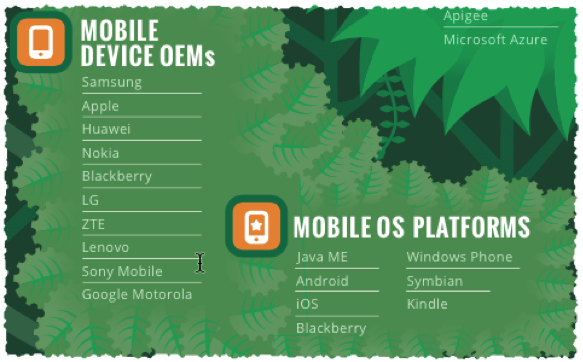
The Mobile Journey
Download your free mobile IT ecosystem poster. It’s the result of 24 months of speaking with hundreds of customers around the world on the subject of their mobile projects and mobile strategy. Our journey also included conducting numerous mobile workshops that introduced customers to the concepts of building an MVP (minimum viable product) as a way get forward motion on mobile initiatives. Along the way we’ve been mapping the mobile IT ecosystem as a way to grasp the sheer complexity of choices, platforms, and technology both developers and enterprise IT have to wade through. It’s no wonder organizations struggle to build custom mobile apps.
Senior IT executives have recognized that mobile apps will be a key instrument for improving connections with customers, partners, and employees. However, the inability to actually get mobile apps out the door has lead to a mobile “app gap.” According to a study by The Economist Intelligence Unit and sponsored by Salesforce, less than half of the 1,300 global executives surveyed had actually deployed apps. And there were lots of reasons for this: complexity of device form factors, limited number of developers, multiple operating systems, and the dizzying array of developer platforms and tools.
Navigating the Mobile IT Ecosystem
 Our protagonist at the heart of this reference graphic represents both the developer and enterprise IT organization that’s facing the vast array of options and vendors in this mobile ecosystem “jungle.” The 8 questions he’s contemplating represent the top questions we’ve heard from both Salesforce customers and prospective customers when considering mobile application development and deployment. The good news is, the answers lie in the jungle. The challenge is, where to exactly find the answers, which ultimately shape your mobile strategy.
Our protagonist at the heart of this reference graphic represents both the developer and enterprise IT organization that’s facing the vast array of options and vendors in this mobile ecosystem “jungle.” The 8 questions he’s contemplating represent the top questions we’ve heard from both Salesforce customers and prospective customers when considering mobile application development and deployment. The good news is, the answers lie in the jungle. The challenge is, where to exactly find the answers, which ultimately shape your mobile strategy.
The easier parts to comprehend are located in the center of this mobile IT ecosystem poster. These are the obvious mobile OS platforms and device original equipment manufacturers (OEMs) we are all familiar with. Many organizations face big decisions when it comes to the devices and OS platforms that need to be supported. For organizations that plan on supplying these devices to employees, these decisions represent a significant capital outlay and shape a significant component of your mobile strategy.

The PaaS, IaaS, and mBaaS at the base of the graphic seem like some kind of geeky acronym-speak. Maybe so, but these elements of the mobile IT ecosystem are directly responsible for the explosion of mobile apps we see as consumers and in social media. All three represent a model for cloud computing – a model for pooling and sharing computing resources and services at incredible scale. And these resources are not managed by you on your own premises, but by a cloud computing vendor or service provider. Platform-as-a-Service (PaaS) is a cloud development model where developers build and deploy apps directly to the service. The Salesforce1 Platform is the leading market example. Infrastructure-as-a-Service (Iaas) is more of an outsourced management model where resources such as compute power, storage, and memory are allocated to applications based on Internet demand. Amazon Web Services is the market leader in this category. And finally, mobile Backend-as-a-Service (mBaaS) is a model for providing web and mobile app developers a method to link their apps simply via APIs to perform things like storage for user information and push notifications that most apps require. Developers don’t have to worry about programming all of this stuff. They simply rely on making API calls to the mBaaS service in their apps.
The most interesting and fasting growing group of technologies in the ecosystem are the JavaScript frameworks, libraries, and mobile app frameworks. JavaScript is the lingua franca of the web. It’s everywhere the visual web is. As the primary language of the web, it’s what web developers want to code in. These frameworks make coding in JavaScript so much easier and provide a level of structure that make developers more productive. And this is why you see so many represented here. They range from low-level libraries (or tools) all the way to pre-fabricated components offered by many of the mobile app frameworks.

As mobile devices proliferate inside the enterprise and organizations deploy more mobile apps, the need for securing these devices, the apps that run on them, and the data stored will be of paramount importance. This is where the mobile device (MDM) and application management (MAM) category of technologies come to the rescue. It should be central to any organizations’ mobile strategy.
A very interesting and specialized category of technology is API management. APIs or application programming interfaces are the digital glue that connect the apps to the services needed to run them as well as much of what you see on this reference graphic. APIs are fundamentally the way to communicate and connect in this modern digital world. API management provides everything you need to engage developers to adopt your APIs as well as protect, secure, and manage the API traffic. One simple example I use to visualize API calls is by thinking about all of the APIs that are being called on Friday night when you are ordering up a Netflix move – each device that people use at home is making an API call to the Netflix service. That requires some serious API management.
Salesforce: Your Guide Through the Jungle
Salesforce doesn’t pretend to eliminate the entire complexity represented in this mobile IT ecosystem. However, we can definitely help organizations and enterprises begin rationalizing their mobile initiatives with a platform
 and strategy that will help you get mobile apps out the door. Every enterprise IT shop should have the Salesforce1 Platform on their “tool belts” when the need arises to tame the wild frontier of mobile app development.
and strategy that will help you get mobile apps out the door. Every enterprise IT shop should have the Salesforce1 Platform on their “tool belts” when the need arises to tame the wild frontier of mobile app development.
But don’t simply take our word for it. You can visit our customer showcase and mobile app gallery and see why many organizations have chosen the Salesforce1 Platform as their layer of innovation and platform of choice for their mobile strategy.
Click HERE or the image below to download your free mobile IT ecosystem poster.